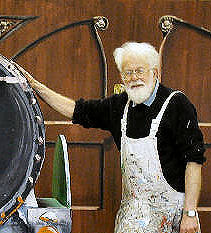GRAINING WOOD. Here is a clearer photo of the doors as seen in the background of the engine photo of previous post.


To paint the grain of these doors. I first of all put on a base coat of lightish brown. I did this all over the two boards, long before painting on the panels. Once the base coat was dry I then went over the boards again with a reddish brown and, as I painted, I occasionally added in some black and melded it into the paint. Then, before this top coat was dry, I crinkled up newspaper and dragged the paper from top to bottom to simulate grain. I could not do the whole two doors in one session as the paint dried too quickly so had to do strips at a time. I kept fiddling about with this work (repainting areas) until I was happy. I then let it dry and afterwards put in the panels, door furniture and shadows/highlights. Here's a close-up. The nearest the audience will be to these two flats is about forty feet.
 CURTAINS. Now to paint the curtains.
CURTAINS. Now to paint the curtains.
 Like the doors, I first put on a base coat of the main colour of these drapes. However, unlike the doors, whilst the paint was still wet, I added a darker colour to be the folds. In the background of the above photo I have left a little of the real curtains for you to see the various values of colour. The dark folds are darkest in the depths of the fold and get lighter as they near the outside. I often do this by first dipping a clean wide brush in clean water then dipping the edge of that brush in a dark colour. Now I do a few "practice" strokes on a spare piece of board which evens out the colour so that my brush is loaded with dark colour on one side which gaduates to clear on the other side. I then paint this as the folds. Next, once the folds have been painted, I put in the highlights of a lighter version (a tint) of the base colour. And finally I use a small brush to paint pure white to put in the bright front edges of the folds .
Like the doors, I first put on a base coat of the main colour of these drapes. However, unlike the doors, whilst the paint was still wet, I added a darker colour to be the folds. In the background of the above photo I have left a little of the real curtains for you to see the various values of colour. The dark folds are darkest in the depths of the fold and get lighter as they near the outside. I often do this by first dipping a clean wide brush in clean water then dipping the edge of that brush in a dark colour. Now I do a few "practice" strokes on a spare piece of board which evens out the colour so that my brush is loaded with dark colour on one side which gaduates to clear on the other side. I then paint this as the folds. Next, once the folds have been painted, I put in the highlights of a lighter version (a tint) of the base colour. And finally I use a small brush to paint pure white to put in the bright front edges of the folds . What also helps to give these curtains the 3d effect are the shadows I painted to help the illusion of panels and walls. Note the shadow on the rail is further out than on the wall. (I think that is the wrong way round! but it works)
What also helps to give these curtains the 3d effect are the shadows I painted to help the illusion of panels and walls. Note the shadow on the rail is further out than on the wall. (I think that is the wrong way round! but it works)

1 comment:
This is a test of comments
Post a Comment